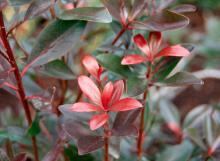Ternstroemia gymnanthera
Common name:
Japanese Ternstroemia
False Japanese Cleyera
Pronunciation:
tern-STRO-mi-a jim-NAN-ther-a
Family:
Pentaphylacacaeae
Genus:
Synonyms:
Ternstroemia japonica
Type:
Broadleaf
Native to (or naturalized in) Oregon:
No
- Broadleaf evergreen shrub/tree, 8-10 ft (2.5-3 m) high, 5-6 ft (1.5-1.8 m ) spread, distinctly upright oval, densely branched, can be grown as a small tree. Leaves simple, alternate (but appear whorled at end of stems), leathery, narrow-oblong to ovate-oblong, 6-10 cm long, apex bluntly pointed, wedge shaped at base, lustrous dark green above and paler below, petiole reddish (petioles and buds together form a "red eye" at the base of a leaf cluster). New growth is reddish, leaves may turn bronze color in winter. Flowers perfect, white to yellowish, 12 mm diam., borne singly or 2 to 3 together, late spring. Fruit is egg-shaped, 2.5 cm long, green to yellow, red-orange, ripens in early fall.
- Shade or partial shade. Prefers moist, well-drained soil, intolerant of wet sites. Responds well to pruning.
- Hardy USDA Zone 7 Native to Japan, Korea, Taiwan, China, India, Borneo.
-
Note: Ternstromea gymnanthers and another species, Cleyera japonica, are superficially similar and often confused in the nursery trade. Michael Dirr (2009) states the two species differ in “minute floral characteristics”, but the easiest way to differentiate them is by the way their leaves are displayed. Ternstomea leaves are in pseudo-whorls (crowded at the apex of the stem like Pieris), Cleyera leaves are alternate and widely spaced to the end of the stem.
- Ternstroemia: after Christopher Ternstroem, Swedish naturalist and traveller in China, died 1748.
- Oregon State Univ. campus: north side of the Memorial Union, west end; large plant along the sidewalk NW Strand Ag. Hall












